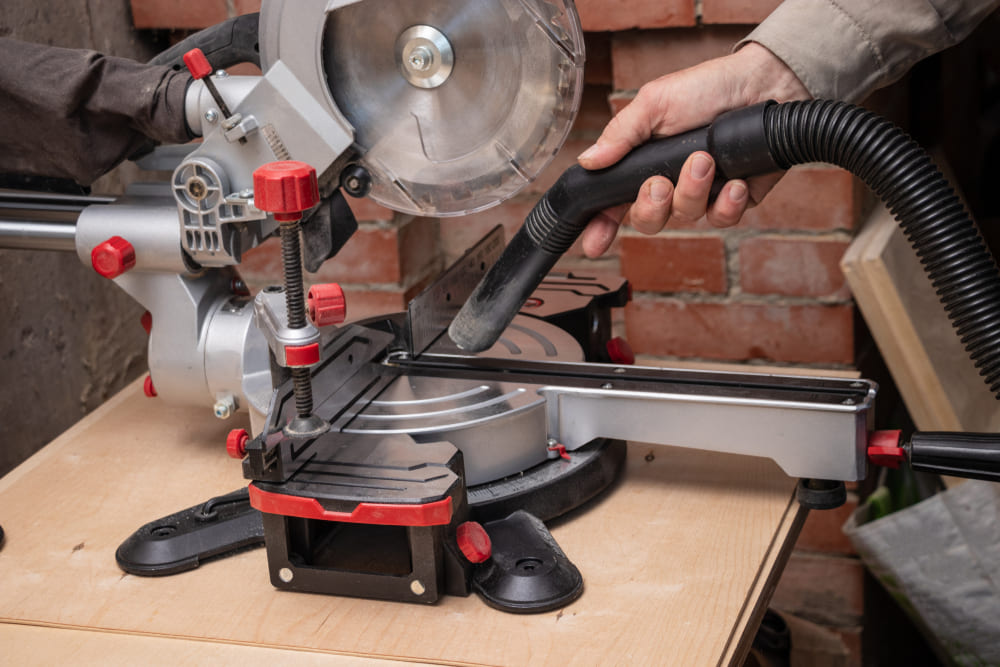YOUR NO 1 WOODWORKING POWER TOOLS RESOURCE WEBSITE
Dust Extraction in Woodworking: 9 Best Practices for a Cleaner Workshop

Disclosure: If you click on some of the links, we may earn a small referral fee. Please know that we only recommend products that we use and believe will add value to our readers.
Are you tired of the constant clean-up after your woodworking projects? Do you find yourself sneezing and coughing due to the accumulation of wood dust in your workshop? It’s time to take control of the situation and create a cleaner and safer working environment.
In this article, we will guide you through the best practices for dust extraction in woodworking. From selecting the right equipment to optimizing dust collection during woodworking processes, we’ve got you covered. By implementing these practices, you can minimize the health risks associated with wood dust exposure and maintain a tidy workshop.
Understanding Dust in Woodworking
When it comes to the types of dust generated in woodworking, it varies depending on factors such as the type of wood being used, the method of cutting, and the aggressiveness of the machine cutter or blade profile. Common types of wood dust include fine dust particles, chips, and sawdust.
Fine dust particles suspended in the air can easily be inhaled, posing the greatest risk to human health. These particles can penetrate deep into the lungs, increasing the risk of respiratory issues and other health complications.
To address the risks associated with wood dust, government regulations on dust control have been implemented to protect workers’ health and safety. These regulations emphasize the need for effective dust extraction systems and proper control measures to minimize exposure.
Selecting The Right Dust Extraction Equipment

When it comes to dust extraction systems in woodshops, you basically have 3 options: shop vacuums, dust extractors, and dust collectors.
Shop Vacuums
Shop vacuums are versatile and commonly used in workshops for general-purpose cleaning. They are effective for small-scale dust extraction, especially for handheld tools. Shop vacuums are portable and offer high-velocity suction. However, they may not be suitable for larger stationary tools or handling large volumes of dust and chips.
Recommendation: DeWALT DXV14P Wet/Dry Vacuum
Dust Extractors
Dust extractors are specifically designed for woodworking and offer more power and capacity than shop vacuums. They provide better filtration to capture finer dust particles, promoting cleaner air quality. Dust extractors come in various sizes and configurations, including portable units that can be easily moved around the workshop.
Recommendation: Festool 574837 Ct Midi I Hepa Bluetooth Dust Extractor
Dust Collectors
Dust collectors are the heavyweight solution for handling larger volumes of dust and chips generated by stationary woodworking tools. They have higher air flow capacity, measured in cubic feet per minute (CFM), allowing for extended ductwork and multiple machine connections. Dust collectors are available as single-stage or two-stage units (cyclone dust collectors).
Recommendations:
9 Best Portable Dust Collector Systems For Small Wood Shops
7 Best Cyclone Dust Collectors for Small Shops (Reviewed For 2024)
Considerations For Choosing The Appropriate Dust Management System
Take into account the size of your workshop and the type of tools you use. Smaller spaces may require portable solutions, while larger workshops may benefit from stationary dust collection systems.
- Evaluate the airflow capacity (CFM) of the dust extraction equipment to ensure it can handle the volume of dust generated by your tools.
- Consider the filtration capabilities of the system. High-efficiency filters are essential for capturing fine dust particles and improving air quality.
- Assess the noise level of the equipment, especially if you work in a shared space or have noise restrictions.
Portable vs. stationary dust collectors
Portable dust collectors offer flexibility and can be easily moved to different workstations or job sites. They are ideal for woodworking professionals who need to take their dust extraction system wherever they go.
On the other hand, stationary dust collectors are permanently installed in a workshop and connected to the ductwork system. They provide centralized dust collection and are suitable for larger workshops with fixed workstations.
Optimizing Dust Collection During Woodworking Processes
Here are some key things to consider:
1. Setting up a dedicated dust collection system
Start by strategically placing your dust collection equipment, near the woodworking tools that generate the most dust. This allows for efficient capture directly at the source. Plan the layout of your dust collection system, ensuring that each tool has a designated connection point.
2. Effective dust extraction techniques for various woodworking tools:
Different woodworking tools require specific dust extraction techniques to maximize dust capture.
Table Saws: Table saws are notorious for producing a significant amount of dust. To effectively extract dust from a table saw, consider using a dust hood that covers the blade and directs the dust into a collection system. Attach a dust extraction hose to the hood to capture airborne particles.
Related: 4 Types of Table Saws For Woodworking (+ Top Recommendations)
Miter Saws: Miter saws also generate a substantial amount of dust, especially when cutting wood at various angles. Using a dust collection bag or connecting a dust extraction hose to the saw’s dust port can help contain and remove the majority of the dust.
Related article: Is a Miter Saw Worth It? a Woodworker’s Guide
Routers: Routers create fine, airborne dust particles while working. It is essential to attach a dust extraction hood or fence that surrounds the cutting area to capture the dust effectively. Connecting a dust extraction hose to the hood or fence ensures efficient dust removal.
Related article: 7 Best Budget Router Power Tool for Woodworking | Router Buying Checklist
Sanders: Sanders produce a large volume of dust during sanding operations. Some sanders come with built-in dust collection features, such as dust bags or ports for connecting to a dust extraction system. Utilizing these features helps capture the majority of the sanding dust.
Related article: Belt Sander vs Orbital Sander: Choosing The Best For Your Sanding Needs
Bandsaws: Bandsaws can produce a considerable amount of fine dust and sawdust. Using a dust collection blade guard or enclosure can help capture the dust at the source. Connect a dust extraction hose or collection system to effectively remove the airborne particles.
Related article: Band Saws For Woodworking | Types | Comparison With The Jigsaw
Using dust hoods and connectors: Dust hoods are crucial components in optimizing dust collection. They are mounted on the tool itself or on the surrounding work surface, effectively capturing and channeling dust towards the collection system. Connectors and flex hoses should be used to ensure an airtight connection between the tool, dust hood, and the dust extraction system.
Managing airborne dust during sanding and finishing processes: Sanding and finishing processes can generate a significant amount of fine airborne dust particles. To mitigate this, consider using specialized attachments and sanding pads with built-in dust collection capabilities. Additionally, using downdraft sanding tables or booths with integrated dust collection can help minimize airborne dust during sanding.
Preventing Dust Build-up and Blockages

Here are some key practices to prevent dust build-up and blockages in your dust collection system
3. Regular cleaning and maintenance of dust collection equipment
Make it a routine to clean your dust collection equipment regularly. This includes inspecting and cleaning filters, checking for any obstructions in the hoses or ductwork, and removing any accumulated dust or debris from the collection bags or containers. Regular maintenance will ensure that your dust extraction system operates at its best.
4. Emptying and replacing dust collection bags or containers
Don’t allow dust collection bags or containers to become too full. Once they reach their recommended capacity, empty them promptly to prevent blockages and maintain optimal airflow. Replace disposable bags or clean reusable containers as needed.
5. Other Tips for preventing blockages in the dust extraction system
- Use appropriate dust collection fittings and connectors to ensure a tight and secure connection between the tools, hoses, and dust collection system.
- Keep the workspace organized and clutter-free to allow for unobstructed airflow.
- Ensure that the intake openings of your dust collection system are clear and not blocked by equipment or debris.
- Avoid using flexible hoses that are too long or have excessive bends, as this can impede airflow.
Safety Tips For Effective Dust Control
6. Wear personal protective equipment (PPE)
Always prioritize safety by wearing appropriate PPE such as safety glasses, gloves, and respiratory protection. PPE serves as an additional barrier to minimize direct exposure to wood dust and its potential hazards.
7. Importance of proper ventilation
Good ventilation in the workshop helps to remove airborne dust particles and improve overall air quality. Consider using fans or opening windows and doors to facilitate air circulation.
8. Use pre-separators and cyclones
Implementing pre-separators or cyclones in your dust collection system can significantly improve dust separation efficiency. These devices separate larger wood chips and debris from fine dust particles, reducing the load on filters and enhancing the performance of your overall dust extraction system.
Related article: Cyclone Woodworking Dust Collection Systems (Ultimate Guide + FAQs)
9. Incorporating air filtration systems
In addition to dust extraction at the source, incorporating air filtration systems further improves air quality in the workshop. Air filtration units, such as high-efficiency particulate air (HEPA) filters or ambient air cleaners, help capture and remove remaining dust particles from the air, ensuring a cleaner workspace.
Frequently Asked Questions (FAQs)
How often should I clean my dust extraction system?
The frequency of cleaning your dust collection system depends on the volume of dust generated and the capacity of your equipment. As a general guideline, it is recommended to clean and perform maintenance tasks at least once a month, to ensure optimal performance.
Are there any specific maintenance requirements for different types of dust collectors?
It is essential to refer to the user manual or manufacturer’s guidelines for your specific dust collector to ensure proper maintenance practices, including filter cleaning or replacement, motor lubrication, and overall system inspection.
Can I use a shop vacuum for dust extraction in woodworking?
While shop vacuums can be effective for small-scale dust extraction, they may not have the same capacity and filtration capabilities as dedicated dust collector systems.
See our detailed comparison of the shop vacuum and dust collectors
Should I wear a mask even if I have a dust extraction system in place?
Wearing a mask as an additional precautionary measure is highly recommended. Masks with particle filter cartridges can provide an extra layer of protection against fine dust particles that may still be present in the air.
What is the best way to dispose of collected wood dust?
Seal the dust in a sturdy bag or container to prevent it from dispersing into the environment. Check with local regulations for proper disposal methods, as guidelines may vary depending on your location.
What fittings do I need to connect my dust collector to the hoses and tools?
You may require fittings such as blast gates, connectors, couplers, and adapters. The specific fittings needed depend on the size and type of hoses, the dust collector outlet, and the tool connections.
Final Verdict
Investing in proper dust extraction practices and equipment is essential for the health and safety of woodworkers. By implementing the tips and techniques outlined in this guide, including selecting the appropriate dust extraction equipment, optimizing its use during woodworking processes, and preventing dust build-up and blockages, you can maintain a clean and safe workshop.
Remember to also prioritize regular maintenance, wear appropriate personal protective equipment, and adhere to safety guidelines.
Enjoy our articles? You can follow us on Pinterest for more woodworking power tools tips and tricks.
Save on selected power tools from top brands - Shop Now on Zoro.





